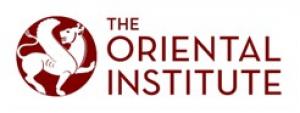
Gallery talk for the Chicago Architecture Biennial on Oct. 19, 2019
An exploration of Assyrian architectural decoration at the OI Museum, including a colossal 40-ton winged bull
Mummies & Martinis on Oct. 24, 2019
A pre-Halloween happening with drinks, music, and tours of the OI’s collection of
mummies led by a UChicago Egyptologist
Continuing its 100th anniversary celebration, the Oriental Institute (OI) of the University of Chicago hosts several festive public programs this month: the OI Indiana Jones Film Festival, a weekend of screenings and discussions on October 11 and 12; a special gallery talk as part of the Chicago Architecture Biennial, The Social Imaginary of an Assyrian Imperial City on October 19; and Mummies & Martinis, a pre-Halloween happening on October 24. These programs feature conversations with OI faculty, curators and researchers, introducing the public to the OI’s pioneering research and study of the earliest civilizations in the ancient Middle East.
Poster image of Indiana Jones and the Last Crusade and Oriental Institute founder James Henry Breasted with his family in 1906.
The OI Museum exhibits the largest collection of ancient Middle East artifacts in the United States, with more than 350,000 artifacts mainly excavated by OI archaeologists and some 5,000 on display to the public on the UChicago campus. For more information on the OI Centennial and a schedule of public events, visit oi100.uchicago.edu.
Marking the 30th anniversary of Indiana Jones and the Last Crusade, the OI Indiana Jones Film Festival on October 11 and 12 offers a weekend of screenings and special events celebrating one of UChicago’s most famous fictional students: Dr. Henry Walton “Indiana” Jones Jr. Allegedly, OI founder James Henry Breasted and fellow pioneering OI archaeologist Robert Braidwood inspired the character of Indiana Jones. In addition to screenings of all three original Indiana Jones films, this two-day festival includes discussions with OI archaeologists and faculty about the themes and locations depicted in the films, a reception at the OI Museum, a trivia event with First Aid comics, and a costume contest. Tickets are free for OI members and public tickets start at $7. For film screening locations and to purchase tickets, visit https://www.eventbrite.com/e/oi-indiana-jones-film-festival-friday-101119-and-saturday-101219-tickets-68194281933.
As part of the Chicago Architecture Biennial, the Oriental Institute presents a special gallery talk, The Social Imaginary of an Assyrian Imperial City, on Saturday, October 19, from 11 a.m. –12:30 p.m. at the OI Museum, 1155 E. 58th Street. OI Museum Curator and Research Associate Kiersten Neumann, PhD, leads an exploration of Assyrian architectural decoration from the ancient Middle East, including a colossal 40-ton winged bull from the palace of the Assyrian king Sargon II at Dur-Sharrukin (modern Khorsabad) in Iraq—a masterpiece of ancient engineering and art. The OI presents a second talk for the Chicago Architecture Biennial, Frank Lloyd Wright's Vision for Greater Baghdad, on November 16. No reservations necessary. For more information, visit https://oi100.uchicago.edu.
Leading up to Halloween, the OI Young Professionals Board hosts its first Mummies & Martinis event at the OI Museum on Thursday, October 24, from 6:30–9 p.m. Open to ages 21+, the event includes festive Halloween-themed beverages and appetizers, a DJ, and small group tours of the OI galleries led by UChicago Egyptologist Foy Scalf—including the coffin and mummy of the Egyptian singer-priestess Meresamun, a colossal statue of King Tut and a section of The Book of the Dead papyrus. Tickets are $15 and include two drink tickets; advance registration is recommended by visiting https://www.eventbrite.com/e/mummies-and-martinis-tickets-69363123971. Free parking for the event is available in the Lexington lot located behind the OI on University Avenue.
About the Oriental Institute
Both a pioneering interdisciplinary research center and a world-renowned museum, the Oriental Institute (OI) of the University of Chicago aims to understand, reveal, and protect the earliest civilizations. Since its founding in 1919, the OI has conducted field-defining research across the Middle East, including excavations and field projects; linguistic research deciphering ancient languages; creating comprehensive dictionaries; reconstructing the histories, literatures and religions of long-lost civilizations; and preserving the region’s imperiled cultural heritage. OI research has uncovered new ways of seeing what connects humans and why—providing insights into the ancient world and the challenges societies still face today, from environmental change to immigration to disruptive technologies. OI field research continues today in Egypt, Israel, Jordan, Iraq, Turkey, and Afghanistan. Much of this research is on display at the OI Museum, located on the UChicago campus and home to the largest collection of ancient Middle Eastern artifacts in the United States with 350,000 objects. As part of its centennial celebration, the OI has completed a comprehensive reinstallation of its galleries, with some 500 artifacts from the collection that have never before been on permanent display; a new space devoted to the Islamic period; a monumental relief from Persepolis, which had been on loan for 80 years to the Boston Museum of Fine Arts; and a special exhibit, “We Start Here: The OI at 100” commemorating the highlights of a century of OI discovery and research. Learn more at oi100.uchicago.edu.
About the University of Chicago
The University of Chicago is a leading academic and research institution that has driven new ways of thinking since its founding in 1890. As an intellectual destination, the University draws scholars and students from around the world to its campuses in Hyde Park and Hong Kong, and centers around the globe. The University provides a distinctive educational experience and research environment, empowering individuals to challenge conventional thinking and pursue research that produces new understanding and breakthroughs with global impact.
